February Newsletter
Here we are in February, a bit more than half way between the end of Fleet 5 racing in 2019 and the start of racing in 2020. This provides us with a nice vantage point from which to look back on the past year, and ahead to the next.
Looking back, the weather gods certainly favored us with consistently nice conditions for the first two thirds of our 2019 season. I recall that we only missed one of the scheduled 13 race days including Race Week, and 30 races were offered over those 13 days. Those same weather gods apparently took an August vacation, when we only got in 3 races total on just two of the four scheduled race days, but they were back on the job for two nice Labor Day race days. By my rough count over the full season we had 16 MRA and RW race days, and roughly three times that number if you count Twilight and Sunday opportunities. We could have sailed 29 MRA races, 10 more counting RW, and another dozen or so including Twilights. Add 8 more at the Nationals in nearby Hingham, and have about 60 opportunities in total. We are all incredibly lucky to have this smorgasbord of chances to go sailboat racing, and we are doubly lucky to have an army of race committee volunteers who are not only willing to set all those courses and take all those finishes for us, but also can to put up with our occasional whining and second guessing and mindless forcing of general recalls! Never forget that we’ve got it really good here, so take advantage of it!
A challenge that Fleet 5 shares with MRA more broadly is the steady decline in the number of boats making it out to MRA starting lines. In terms of the number of boats registered in the various MRA fleets, the decline over the past five years is pretty modest; 87 total boats in 2015, 85 in 2017, and 82 in 2019. However, a closer look at those numbers reveals a number of ‘zombie’ boats in each of the fleets that did not make a single start all season long, and a considerably larger number who only participated on a handful of race days. Speaking for Fleet 5, the good news is that people want to be part of our ‘club’, even if for a variety of reasons they don’t or can’t make it out to the startling line. The bad news is that our lives are so busy and fragmented these days that we struggle to find the time that it takes to do what we may enjoy doing most.
This brings us to the looking ahead part. By far the best way to maximize the number of days that we can make it to the starting line on a more consistent basis in 2020 is to start planning and prepping for it now.
First up is the need to take a close look at the 2020 schedule; we expect the MRA dates to look familiar next year, and negotiations for hall passes for Saturdays (and a Sunday or two) from Memorial Day through Labor Day should start ASAP. In addition, vacations should be scheduled around making the East Coast Regatta in Manchester on June 5-7, Marblehead Race Week July 23-26, and the Nationals here at the CYC on August 26-29 (more on this later in this issue).
Next up is the boat; some of the more anal among us make detailed lists at the end of each season noting all the things that they think should be upgraded or replaced before the following year. However, others may be more like me, who haphazardly remember some critical items in late May, and note other omissions midway up the first beat of the new season. To help us all through this, David Reynolds (#722) has written a really helpful article on R19 maintenance (see below) that we should all read carefully and digest. Checking up on the specifics that David mentions, and applying his proactive approach to the rest of the boat before the season starts will help avoid breakdowns later on. Don’t be like me, and have a bad halyard lead shred a cover on the last day of the Nationals, and force eight bare headed sail changes in the final three races!
FLEET 5 GOVERNANCE:
We have had one Fleet 5 Leadership meeting on October 18 chez Taylor, and another on February 6 hosted by Elise, as 8 Wyman has become a construction site. Fueled with pizza and beer, the following topics were discussed.
Leadership; We had a general discussion focused on the need for more turnover (shorter terms) in leadership positions, that would share the load beyond the usual suspects. For 2020, the slate looks like this:
President: Jim Taylor
Vice President: Elise Mazareas Nash
Secretary: Martha Martini
Treasurer: Dave Reynolds;
Social: Larry Ehrhardt
Scorer; Kim Pandapas
Measurer: Stefan Thibodeaux
Webmaster: Nat Taylor
Spring Clinic;
Specifics are still being developed, but the general topic will be preparing for the season and racing; prepping boats, regatta plans, race strategy, etc. Clear your calendars for 7PM, May 7, and join the crowd in the CYC Fantail.
Membership Survey:
Jeff Shoreman suggested, and Elise volunteered to produce, a brief on-line survey, intended to get a better handle on who we are, what we value most in the things that we do now, and what our preferences might be for what we could do in the future. Please take a few minutes to fill it out. Coming soon!
Special Race Day, May 30:
Larry Ehrhardt has volunteered to coordinate a plan for an ‘out of the box’ day featuring a number of practice starts and multiple very short races, complete with coaching on the course. The goal is early season practice for both sailors and race committee, slotted in between the Memorial Day Regatta (May 23-24) and the MYC East Coasts (June 5-7). 3 races will likely be scored for MRA.
Regattas:
East Coasts – As above, June 5-8, hosted by the Manchester YC.
Race Week – As early as it can be, Thursday July 23-Sunday, July 26.
Nationals – Hosted here in Marblehead by Fleet 5 and the CYC, from Tuesday August 25 thru Saturday, August 29. (More details below)
Social Schedule:
Winter; Big Thank You to Kim & Christina!
Spring; May 30; Kim and Christina will host again, with a special draw being an in depth debrief from all the short course racing that afternoon.
Race Week; Thurs, July 23, chez Uhl
Nationals; Friday, 8/28, Ehrhardt’s
Labor Day; Jim & Charlie?
Awards; (Site and date to be confirmed)
MRA Support:
As mentioned above, the number of boats making it to the MRA lines is down, which has contributed to decreasing volunteer support. Why give up your Saturday when only a handful of boats show up? MRA itself can only do so much in encouraging participation. The fleets, the clubs, and the sailors all need to collaborate on getting boats out.
Communication
Newsletters; Planned for February & April
Web page; It does get traffic, with the ‘go fast’ tips getting a lot of visits. Photos help!
Facebook; we have a presence, fueled largely by the RTTC posts. One suggestion is to create a Facebook Group that members could post to directly, check on crew availability, upload photos, revisit that leeward mark rounding, etc.
Instagram; We don’t, but could, have a presence.
Suggestions & Feedback:
If you have comments, suggestions, or feedback, be sure to send it to us at: ajtaylor8@verizon.net
Trophies in Inventory:

Space on ‘The Shelf” continues to be dominated by the Kaznoski & Cooke Collection, that saw a significant number of additions last November. Since #2648 always seems to be AWOL for our fall awards party, going forward we may not engrave names on their trophies, so they can be awarded to the next best finisher who does show up. The substantial Dave Nelson Collection was swept clean last summer in a direct handoff after Race Week, but it bumped up again last fall with a RW keeper for his ‘oh, so close’ tiebreaker 2nd place to Matt Hooks & Robb Pascal. The Mike Lane Exhibit lasted only until the winter party, but the Team Colsman Collection continues to grow steadily. Prime space on the Shelf is now devoted to glassware for Team Felton, whose 2010 award date easily topped Eric Thornton’s previous delinquency record of 2013.
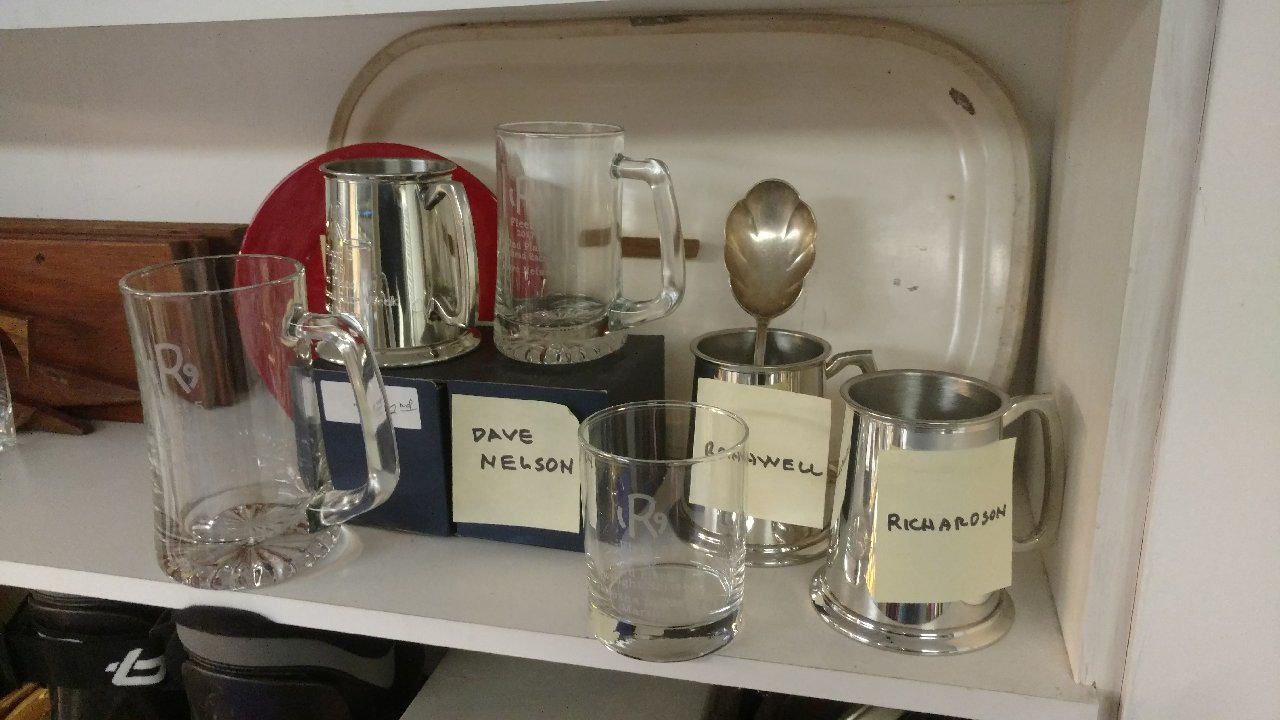
Awards for Bill Rothwell and Ben Richardson have remained on display for several years, as have the red plate and silver spoon that were left at fleet parties. All of this swag can be viewed at 8 Wyman Road and collected by appointment.
Looking Forward; Fleet 5 Hosts the 2020 Nationals:
Elise Mazareas Nash and Kim Pandapas are cochairing the event, to be hosted by the CYC on August 25-29. They have assembled a terrific team that is off to a great start and has already held two organizational meetings. Their goal is a provide spectacular regatta that will attract as many as 50 boats. An NOR is already available on line at the following link: http://2020nationals.rhodes19.org/2019/09/30/2020-nationals/ Among the many challenges will be finding housing and charter boats for some out the out-of-towners. The event leadership is grateful for the support of the volunteers that have already stepped up, but in the end the effort will definitely require our entire ‘village’ to help with greeting, measurement, on site logistics, registration, etc. Please reach out to Kim kpandapas@comcast.net or Elise at elise.mazareas@gmail.com to find out what their needs are, and how you can help.
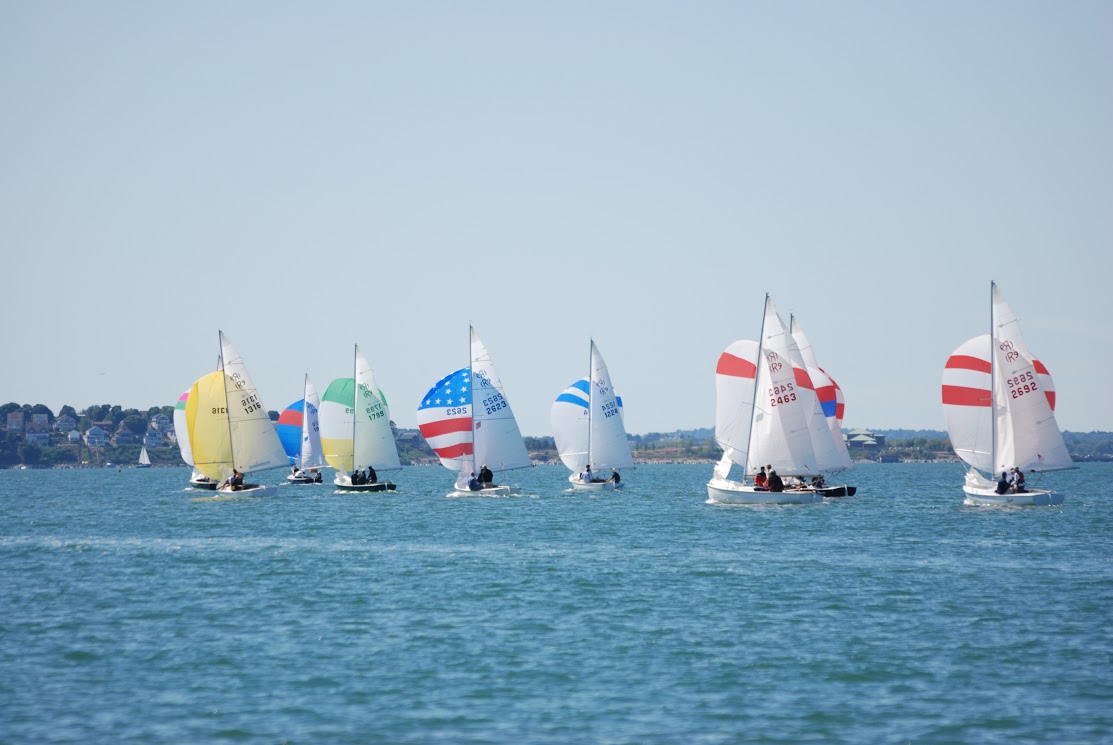
Since our ‘Hacker of the Year’ honoree is not known until the end of our awards night, the Hacker perpetual trophy (lovingly crafted by Fleet 5 artisans) cannot be engraved with the name of the offending party until the following year, when a suitable ‘keeper’ can also be presented. Due to an oversight, we still owe one to class stalwart Steve Uhl for falling out of his boat as he crossed the line of an August, 2018 race. A trophy for Steve will be custom crafted from the Felton Lumber Inventory and awarded belatedly in 2020, along with the one earned by Stefan.
Alex & Coni Collection
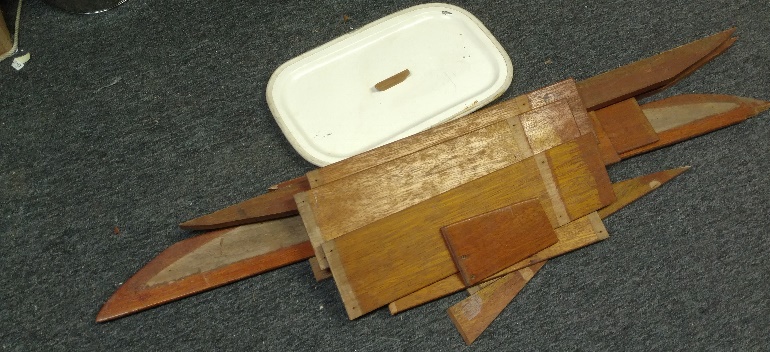
In addition to donating the Felton Lumber Inventory mentioned above, Alex and Conway have pledged to add some early O’Day vintage original Rhodes 19 hardware (perhaps suitable for Hacker Award keepers) to the lumber and bulkhead access panel cover already on display. The curator of their collection is not yet in receipt of these most recent artifacts, however.
New Boats:
Jeremy Bloxham still swears that his boat is almost done, that the fun part (laying out the hardware) is next, and the he and Katie should be on the line by Race Week. That would be great, but Jeremy has been saying that for years.
Peter Sorlien’s was still being finished on the race course at the Hingham Nationals last year, but with the kinks now out, and despite the fact that he now resides in New Hampshire, he plans to compete early and often in 2020.
We are thrilled to have former CYC commodore Timmy Dittrich join our fleet, although seeing #1217 back on the course will no doubt make a lot of us twitch. Timmy has been an IOD owner and competitor for +/-25 years, and is looking forward to doing less boat maintenance and more sailing. You can’t do a singlehanded harbor tour on a whim in an IOD, but you absolutely can in a Rhodes.
January Party;
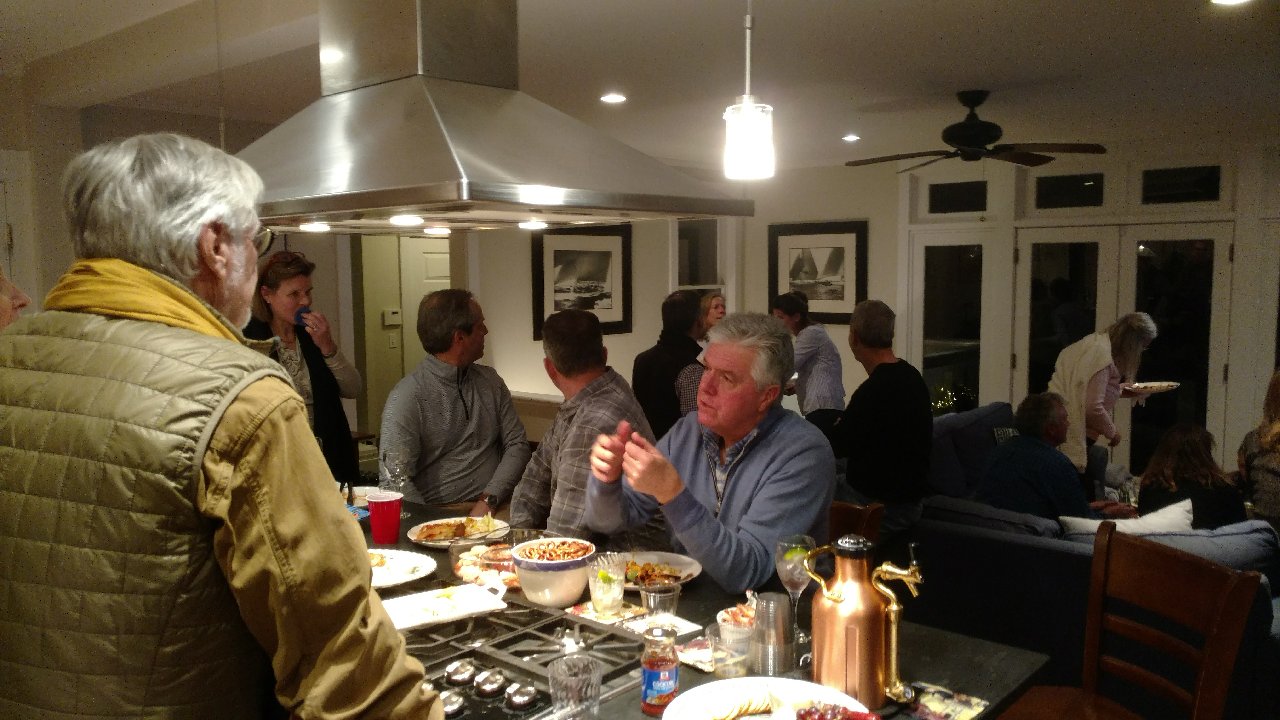
Huge thanks to Kim and Christina for hosting yet another January party, this time at their elegant new digs down the street from the CYC next to Chandler Hovey Park. Lots of folks enjoyed it, including old (long time?) friend Doug Trees. It is always great to catch up with so many others that also carry the sailing disease, for which there is no known cure.
Things to do before next season!
And why you should not do boat preparation like Ed, and be sure to read David Reynolds’ article!
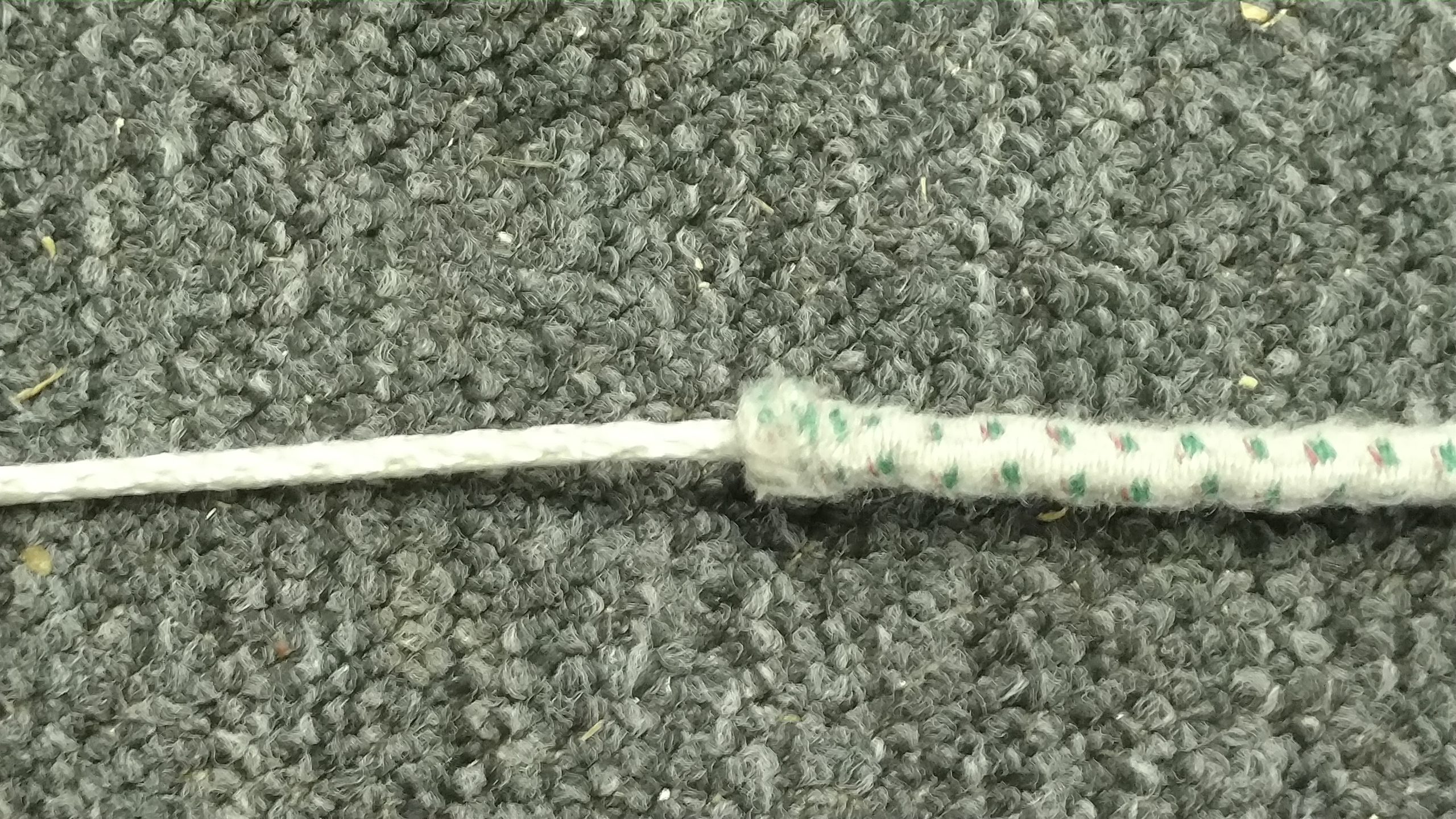
The offending spin halyard on #1926 that redquired bare headed sail changes at the Nationals
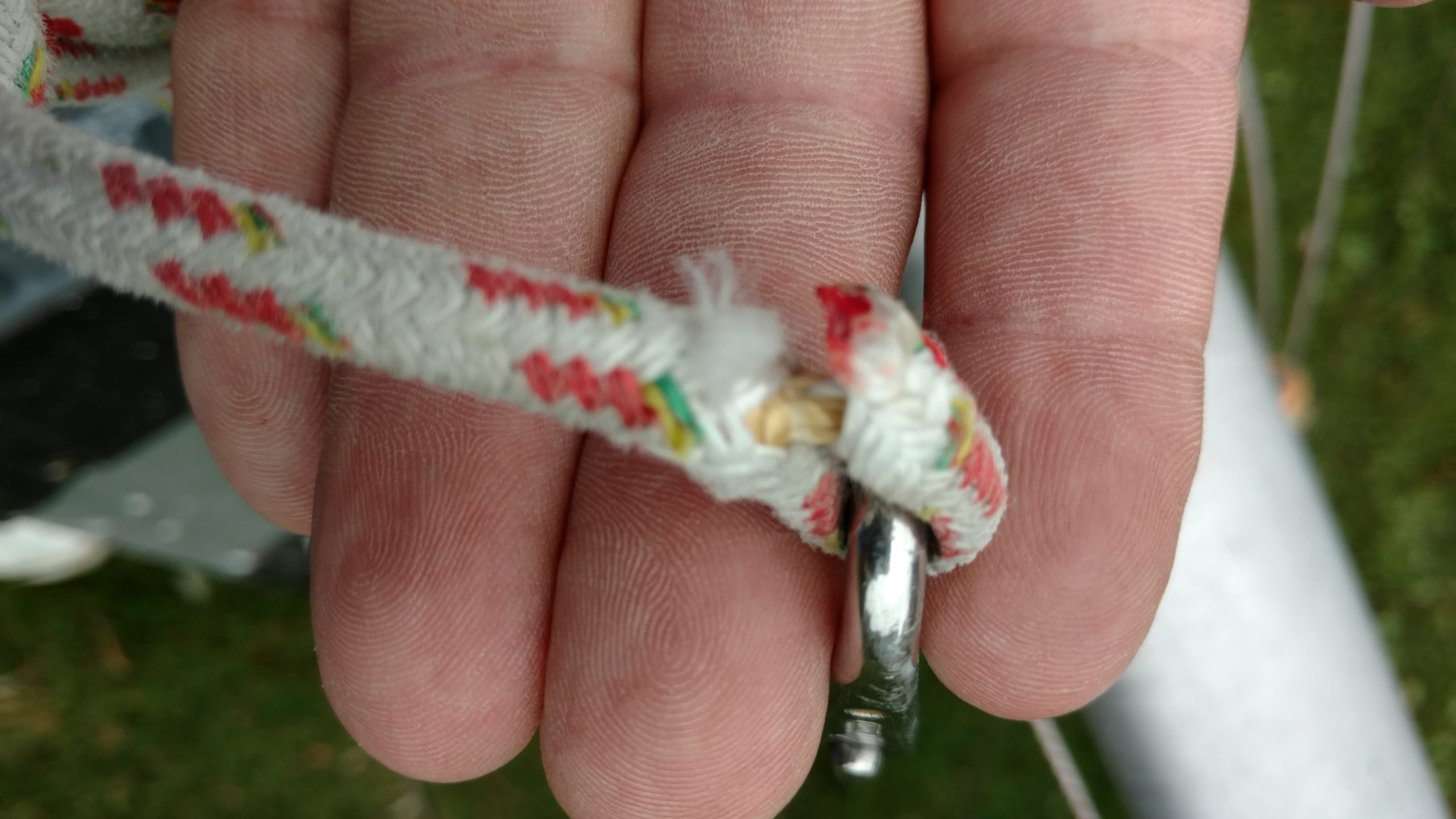
The jib halyard could go the same way…
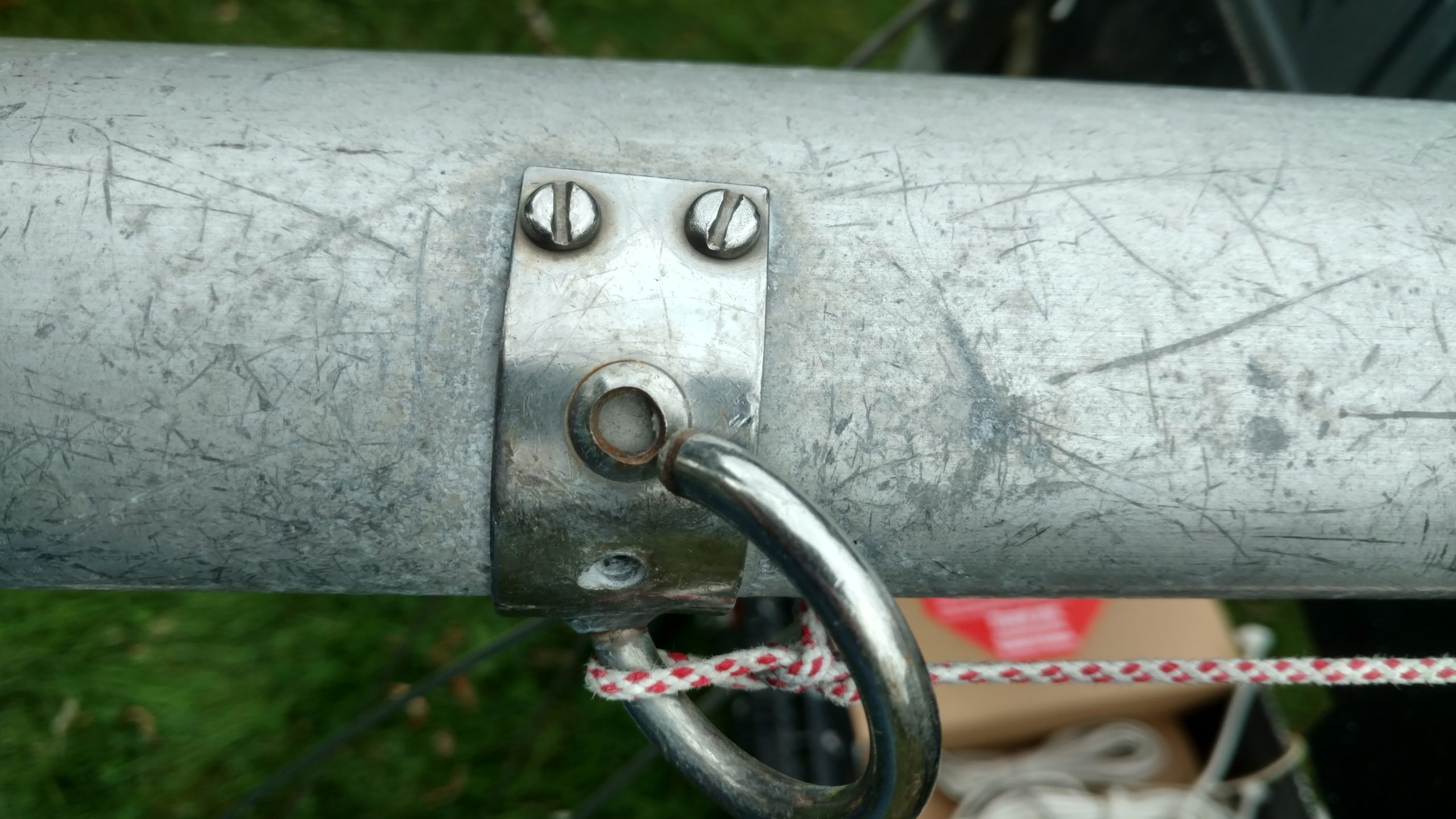
This pole ring survived the Nationals, barely
Rhodes 19 Maintenance
By David Reynolds (#722)
If you are a member of the Rhodes class, then it is almost certain that you own or sail on a boat that was originally built many years ago. Sure, newer boats have been built, and I understand you can still buy a new boat from Stuart, but what I see on the water when I look around are mostly old boats. This is due in part to the fact that there are lots of older boats out there and turnover in the class is relatively low but also, I think, because conventional wisdom suggests that a well-maintained older boat will be faster than a new one.
Like most of you, Jeff Shoreman and I are owners of an older boat. It had been salvaged, repaired, and transformed into a competitive boat (Thanks to Shan McAdoo and Paul Adam) before we bought it. We have sailed it now for more than 10 years, and since neither of us plan on giving it up anytime soon, I’ve started to think more and more about how to keep it both seaworthy and fast.
Of course, we have maintained an annual ritual of repairs and small upgrades. These are mostly focused on fixing things that are seriously damaged
(Think collisions. Yes, we’ve had some.), replacing running rigging (Sun and salt water take their toll.), and making minor upgrades based on ideas shared by many of you (This year it’s an angle of heel indicator). For sure, this annual ritual is important and necessary (If you are looking for guidance on this, I recall that Kim has written at least one previous newsletter article on this topic), but it may overlook some of the structural parts of the boat that age slowly over many years.
In this article, I’ll share my thoughts on five important parts of the boat that can and will age over time. By no means do I consider this article to be the definitive voice on these topics. After all, the author only has 10 years of experience as a Rhodes 19 owner. Rather, I hope to spark your thinking about these issues and invite you to share your thoughts with me (reynolds.davidc@gmail.com) and the rest of the fleet.
- The Mast: Over time, a mast is subject to an enormous amount of fluctuating stress. Engineers have a technical term for this constant battering; they call it fatigue. In any metal structure, continual fatigue stress (bending back and forth) eventually weakens the metal and increases the likelihood of failure. In addition, any sharp edges or corners tend to concentrate the effects of fatigue or bending (Engineers call this stress concentration), again increasing the chances of failure.
Newer masts have been built with an eye towards eliminating sharp corners but I’m told that many older masts had significant cut-outs near the deck and the hounds. Regardless of the age of your mast, it’s a good idea to annually check for signs of fatigue failure around any cut-outs or fittings.
- The Ribs: As the skeleton of a Rhodes, the ribs play an important role in maintaining the strength and shape of the hull. Any weakening of this skeleton will affect the stiffness of the boat and/or the profile of your bottom. Loss of structural rigidity is bad for speed, and to keep your boat fast, you definitely want to prevent or correct any deterioration of this skeleton.
Two common problems are softening of the ribs or separation of the ribs from the hull. You can visually inspect for both of these problems but, if you have any doubts, I’d recommend getting a 2nd opinion from someone with experience. If the ribs are strong but not secured firmly to the hull, the ribs themselves can possibly be salvaged, but if the ribs have started to rot and lose structural integrity, you will want to replace them.
During McLovin’s last check-up with Chris Small, we found that the ribs were starting to go, and Chris replaced most of the previous wooden ribs with foam ribs that are covered in fiberglass. With the wood removed, we have eliminated the chance of rotting and hope that McLovin’s new skeleton will last for many years.
Of course, wooden ribs are still a very good option provided they are well maintained and protected from rotting. Jim Taylor claims that Jabberwock is still sailing with its original ribs (> 40 years), and since that boat still looks fast enough to me, I’ll share with you his approach to rib maintenance. It’s quite simple: Let them get wet but let them dry. When he bought the boat 30 years ago, the ribs had been covered with fiberglass. This might sound like a nifty trick to keep the water out but it’s far more likely to just trap any moisture next to the ribs, accelerating
rot. Jim removed all the fiberglass that covered the ribs and has left the ribs exposed ever since. During the winter, he covers the boat only with a tarp – not shrink-wrap. This allows the flow of fresh air through the hull, keeping the air dry and preventing excessive condensation.
- Floatation: I can recall only one instance in Marblehead where the floatation in a Rhodes was called into action. In this case, it happened to a sailor, Mike Lane, that I greatly respect for his confidence and skill in heavy weather. If it can happen to Mike, we should all be prepared for it. Thankfully, the solution is easy – keep the seat and bow tanks as watertight as possible and fill them all as full as possible with something buoyant in case the tanks leak. Three good options are:
- Closed cell foam: This can be cut to fit into tight openings and seems to last a very long time. This is what we have in McLovin’s tanks.
- Inflatable bags: These can expand to fill the space and I believe Bight Me used these in the bow at one point.
- 2 liter bottles with cap: They can fit through a small porthole, last forever, and are the current floatation solution on Jabberwock.
- Keel bolts: These things are important for obvious reasons. For starters, a wobbly keel is not fast. Furthermore, many of us hoist our boats from the keel bolts, and any failure on the hoist could lead to significant damage and/or injury.
Back in the day, O’Day used to deliver Rhodes’ hulls and keels separately to retailers who would then mount the keels for the customer. This means that many keels have likely been remounted over the years to correct errors in
alignment made at the point of sale and that there will be a diversity of DIY keel mounting solutions found across the fleet. Regardless of how your keel has been mounted, it is likely that the rigidity of the mounting will slowly decrease due to undesired reactions between the various materials used. For example, original ribs were made of white oak which is strong and durable. However, it can react with iron to form an acid which causes the oak to crumble and lose structural strength. Likewise, stainless steel bolts prevent surface rusting but offer only offer rust protection in the presence of oxygen and could rust where they are embedded in the keel or deteriorate due to a reaction with lead.
There are lots of ways to check for deterioration of your keel mount. Start with checking under nuts and washers for signs of rust or rib failure. Inspect the hull for any signs of rust or cracking between the hull and keel. Pull laterally on the keel (while hoisted) to check that it is firmly attached to the hull. Finally, ask others to inspect your boat with you. There are a lot of people in the fleet who have removed and attached keels themselves and know exactly what to look for.
When it comes time to reattach your keel, the right solution will depend in part upon the condition of your keel and the design of your ribs. McLovin started to show signs of rust on the keel last year, and we decided to replace the original lead keel with a new composite one. Stainless steel bolts now attach the keel to fiberglass ribs plus Chris Small also uses fiberglass to bond the keel onto the hull, providing additional structural strength. If you are sticking with oak ribs and a lead keel, the best solution would likely be to use stainless
steel (or bronze) bolts and strengthen the attachment with fiberglass.
I hope that this article has got you thinking about the long-term health of your boat. If you have any doubts about the condition of any of these items (especially your floatation or keel bolts), ask a professional or an experienced fleet member to take a look at your boat with you.
1K
Racer’s Resource Board
Dave Whittier of Stuart Marine in Rockland Maine is the exclusive builder of Rhodes 19s. Call Dave at 207-594-5515 for pricing on new boats, used boats, repairs and parts.
Doyle Sails at (978) 740-5950 for new sails and repairs.
Chris Small – Full restorations and glass work- csmall9021@yahoo.com (978) 500-9021.
Seacoast Specialty Marine Call Greg Dolan at 978-255-2769, click on seacoastspecialtymarine.com, or visit on Facebook @seacoastspecialtymarine.
Neal Lewanda – Repairs, fiberglass/gel coat, rudders, keel work, etc. – neal@lewandamarine.com, 978-525-2700
Benjamin Parker of Aequoris Yachts does glass work and boat repair. Contact Ben at 58 Gregory Street, Marblehead (207) 319-3583 or benjamin.parker@aequorisyachts.com.
Waterline Systems provides a complete range of services. Call at (401) 682-1661.
Cape Cod Shipbuilding makes Zephyr extrusions and a full range of mast and boom hardware and fittings. Call Dick Landis at (508) 295-2240.
The Trailer Shop – Located on 87 High St. in Danvers for any trailer repairs. Call Dan Sullivan at (978) 750-6799
Sailor’s Tailor www.sailortailors.com for boat covers, rudder bags and marine stitching.
Notice Board
Donate Your Sails The Nahant Sailing Program (NSP) has 6 Rhodes 19s that are used to teach kids and a twilight program for adults. The majority of funding comes from an annual fund raiser by The Friends of Nahant Sailing. The Rhodes sails need replacement, so if you have or are purchasing new sails, please consider donating your old ones to “The Friends of Nahant Sailing.” Not only will it help the program grow, but the donation is tax deductible. Please contact Bob Cusack at (781) 581-1159 or rjcusack@verizon.net if you are interested.
* * *
The next Fleet 5 publication will be the April Newsletter. All of our publications are distributed by email. To request being added to (or removed from) Fleet 5’s distribution list, please contact Marth Martini at martini1466@gmail.com. To respond with comments, suggestions, news, and/or complaints, email Ed at ajtaylor8@verizon.net